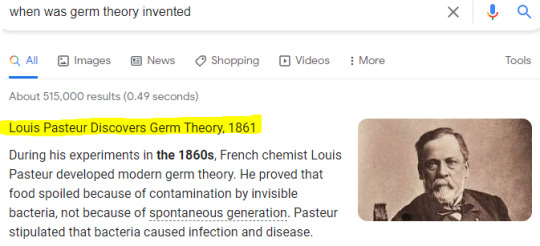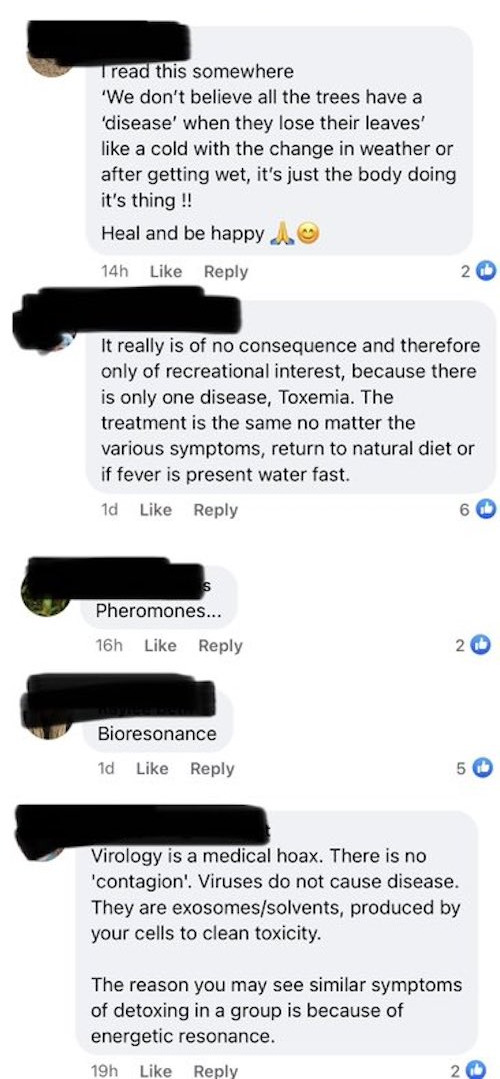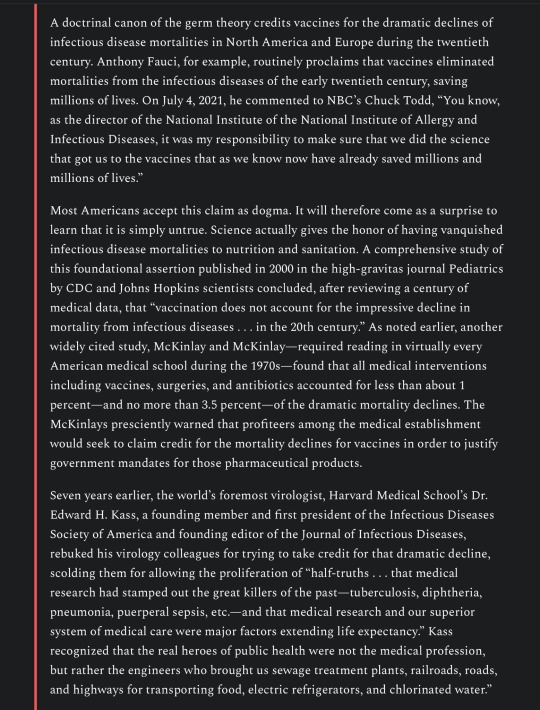#germ theory
Text
We were sold a "virus" is jumping all over, but in reality we all faced a bait and switch by the rockefeller medical system. Free the mind from the fear of germs and elevate your knowledge.
Books on the topic:
The contagion myth Dr. Tom Cowan
Dissolving Illusions
The invisible rainbow 🤔
1923 Lancaster Study: 👇
#pay attention#educate yourselves#educate yourself#knowledge is power#reeducate yourself#reeducate yourselves#think about it#think for yourselves#think for yourself#do your homework#do some research#do your own research#ask yourself questions#question everything#lies exposed#news#germ theory#virus#medical corruption#you decide
141 notes
·
View notes
Text
Now I don’t want to alarm anyone but...

Philip went to the Demon Realm in the 1600s...

Germ Theory was discovered in 1861...
CONCLUSION:
PHILIP WITTEBANE HAS NEVER WASHED HIS HANDS EVER, NOT EVEN ONCE!
#the owl house#spoilers#elsewhere and elsewhen#hollow mind#philip wittebane#germ theory#every time he gets sick he blames it on wild witches
752 notes
·
View notes
Text

That "I still don't want to get it" thing it seems to be what people are confused about.
There's still so much we don't know about Long COVID, or even why some people get so much sicker than others.
So yeah I'm going to continue to pass on breathing in your plague cooties.
#covid#plague#Doom 2023#germ theory#Yes I do spray the elevator buttons with sanitizer#at least it's yuzu scented instead of vodka scented
18 notes
·
View notes
Text
So that post about monsters inc and the “scare shortage conspiracy” is going around and it’s fun. But it also theorizes that the idea that’s kids are toxic is also a lie to limit competition and research into “scream collection”. But personally I think the misconception is a lot simplers and dumber than that.
The monsters have been scarring kids for a long time, no matter if it’s time travel or dimensional hijinks, since there’s been cryptids for a long time the movies say those are banished monsters. Well germ theory and modern vaccination is relatively new compared to all of that. Kids aren’t toxic from radiation, they’re just infectious.
Anything from tuberculosis to chickenpox, heck even the common cold would spread like wildfire since the monsters don’t have immunity from human disease. Over the years all the warnings of infection and disease risk would just be simplified to DO NOT TOUCH.
#
3 notes
·
View notes
Text
“In the eighteen seventies and eighties, when the ideas of the new biology began to circulate in the American middle class, they were greeted with a suspicion which often bordered on moral revulsion. Darwin's theory of evolution—the most brilliant synthetic breakthrough of nineteenth- and perhaps twentieth-century biological science—‘shattered the Christian cosmos.’ It was not only that the theory violated the letter of the Old Testament; Darwinism went further and asserted that the world of living creatures could have gotten the way it is without the intervention of God, in fact, without conscious effort on anybody's part. What was left, in the view of leading American Christians, was a godless universe, a moral desert—
Life without meaning; death without meaning; the universe without meaning. A race tortured to no purpose, and with no hope but annihilation. The dead only blessed; the living standing like beasts at bay, and shrieking half in defiance and half in fright.
The spiritual implications of the new biological truth were, as one minister put it, ‘brutalizing.’
In a lesser way, biology's second great contribution to popular culture—the Germ Theory of Disease—further undercut the religious foundations of morality. Traditional religion saw individual disease as the price of moral failings, epidemics as acts of a vengeful God. In the mid-nineteenth century, Albert Barnes, a leading Presbyterian minister, declared cholera to be a punishment for the ‘vanities of natural science,’ especially Darwinism. But, through the lenses of the new high power microscopes available in the mid-eighteen hundreds, disease began to look like a natural event which depended less on God than on the growth rates of what appeared to be fairly amoral species of microbes. If diseases were dispensed in some sort of microbial lottery, rather than by moral plan, then indeed this was a ‘race tortured to no purpose.’
In order to become a moral force in society, biological science had had to undergo a kind of moral transformation itself. For example, Darwin's popularizers managed to identify ‘evolution’ with ‘progress,’ as if natural history were a long uphill moral pilgrimage. This stratagem excused some of the more savage aspects of natural selection and—even more important—it left room for a divine Plan. The laws which science was uncovering would turn out to be the expression of the will of God—revelations of the divine Plan. Thus science could provide moral guidelines for living: for example, that one had an ‘evolutionary duty’ to ‘advance the race’ through proper selection of a mate, good health habits, etc. By the eighteen eighties it is difficult to find a popular tract or article on any subject—education, suffrage, immigration, foreign relations—which is not embellished with Darwinian metaphors. Charlotte Perkins Gilman's classic Women and Economics, the theoretical breakthrough for a whole generation of feminists, appealed not to right or morality but to evolutionary theory. Women's confinement to domestic activities had made them more ‘primitive’ and undeveloped than men. If women were not emancipated, the whole race would be dragged down, she argued (with the naïve racism which was typical of her time):
In keeping her on this primitive basis of economic life, we have kept half humanity tied to the starting-post, while the other half ran. We have trained and bred one kind of qualities into one-half the species, and another kind into the other half. And then we wonder at the contradictions of human nature! . . . We have bred a race of psychic hybrids, and the moral qualities of hybrids are well known.
Germ Theory went through a similar moral transformation. If it was germs and not sin that were the immediate cause of disease, then sin could be still retained as an ultimate cause. Germ Theory was transformed into a doctrine of individual guilt not at all out of tune with old-fashioned Protestantism. Anyone who transgressed ‘the laws of hygiene’ deserved to get sick, and anyone who got sick had probably broken those laws. The English physician Elizabeth Chesser, in her book Perfect Health for Women and Children, warned that ‘the time has nearly arrived when we shall not be permitted to be unhealthy.’”
-Barbara Ehrenreich and Deirdre English, For Her Own Good: 150 Years of the Experts’ Advice to Women
9 notes
·
View notes
Photo




Weapons-grade stupid.
#germ theory#terrain model#virology#science denial#science denialism#toxicity#detox#bioresonance#pseudoscience#pseudoscientific nonsense#pseudoscience vs science#science vs pseudoscience#science#medicine#alternative medicine#quackery#energetic resonance#religion is a mental illness
35 notes
·
View notes
Text
Random Fact #6,439
Before the germ theory of disease (now the accepted scientific theory for how disease works) doctors believed that the plague spread was through poisoned air.
The beaked masks were filled with theriac, a mixture of more than 55 herbs and other compounds including ingredients such as cinnamon, myrrh, and honey. The shape of the beak was supposedly designed to give the air enough time to be cleansed by the herbs before it reached the nose.
While they weren’t entirely correct about what caused illness, the plague doctor masks did in fact help with preventing some illnesses.

#germs#germ theory#viruses#bacteria#did you know#random facts#random factoids#random factoid#random fact#the plague#the black death#plague doctor#medical history#biology#history facts#history
11 notes
·
View notes
Text
This basic template of "overcoming evil" and "asserting dominance" has infiltrated every aspect of our political culture. It's the basic problem-solving template of our society. If there is a problem, find the bad guy, defeat the bad guy, and the problem is solved. This is the basic mentality of war. And what I'm saying is the mentality of war is rests on a deeper place, rests on the story of separation. The basic mentality of war is...as the saying goes, if you have a hammer everything looks like a nail...We become blind to any other way of solving problems.
- Charles Eisenstein in The Secret to Changing the World (The Origin of Wrongness)
#q#quotes#division#blame culture#ostracization#call out culture#bullying#sociology#charles eisenstein#mindful consumption#mindful living#mindfulness#germ theory#holistic leveling up#leveling up#that girl#green juice girl#solarpunk#be the change#politics#yoga#ahimsa#karma#might makes right#mindsets#sidewalkchemistry
2 notes
·
View notes
Text
The Serendipitous Saga of Sneeze: How Hippocrates Stumbled Upon the Microscopic Marvels
In an era shrouded in the mists of time, long before the whispers of the internet and the spectacle of Tumblr, I, Hippocrates, found myself entangled in an adventure most unexpected. My tale begins on a day much like any other, under the azure expanse of the Grecian sky, where fate conspired to send me hurtling down a path of discovery, paved with sneezes, serendipity, and a soupçon of silliness.
It was the season when the air, heavy with the perfume of blossoming flowers, was also thick with the mirth of the gods – or so I thought. For, as I wandered through the verdant meadows, compiling my thoughts on the humors and their influence on man's temperament, I was suddenly besieged by a series of sneezes so vigorous, they threatened to dislodge my sandals. Amidst this nasal tumult, an idea as audacious as the flight of Icarus fluttered into my mind: What if these sneezes were not merely an irritation but a ballet of unseen forces, a battle waged within the confines of my own body?
Intrigued by this sudden epiphany, I resolved to investigate further. My quest for understanding led me to the local symposium, a gathering as renowned for its spirited debates as for its wine. There, amidst the clinking of cups and the hum of conversation, I announced my intention to explore the enigmatic origins of disease, beyond the realms of humors and divine displeasure.
The reaction was a mixture of amusement and skepticism, with my fellow philosophers jesting that perhaps I had imbibed one cup too many. But undeterred, and perhaps slightly emboldened by the nectar of the vine, I embarked upon a series of experiments that would forever alter the course of medical history.
My laboratory became a place of strange sights and smells, as I examined everything from the mucus of sneezes to the mysterious molds that crept upon forgotten loaves of bread. It was during one such experiment, while peering through a makeshift lens at a drop of pond water, that I beheld a sight as startling as it was revelatory. Tiny creatures, invisible to the naked eye, teeming with life and vigor! These minuscule beings, I realized, could be the very architects of ailment Hippocrates had pondered upon.
Emboldened by this discovery, I crafted a scroll detailing my findings and theories. Entitled "The Bodacious Birth of Bacteria," it posited that these invisible creatures were the true harbingers of health and disease, a notion as revolutionary as it was contentious.
Yet, as fate would have it, this scroll would not see the light of day for many an age. In a twist as ironic as any tale of the gods, it was misplaced, lost amidst the papyrus and pottery of my abode, only to resurface centuries later in the hands of bemused archaeologists. These scholars, intrigued by the ramblings of an ancient physician on the nature of invisible foes, would herald it as a pioneering work, a bridge between the ancient and the modern in the understanding of disease.
And thus, my friends, concludes the serendipitous saga that led to the crafting of "Hippocrates’ Insightful Excursion Through the Germ Theory of Disease." A tale woven from the threads of curiosity, misadventure, and a sneeze that echoed through the ages, it stands as a testament to the notion that great discoveries often stem from the most unexpected of sources.
So, as you peruse the marvels of the microbial world, remember the tale of the sneeze that launched a thousand insights. For in the world of science, as in life, the journey to understanding is often as wondrous and whimsical as the destination itself.
0 notes
Text
if i were a victorian era person i wouldve thought germ theory was bullshit too i mean its kinda crazy. ur telling me a tiny invisible creature is climbing into my body and making me sick? yeah fucking right. its the smells.
0 notes
Text

You didn't think you needed to regularly wash a thing you put your mouth on.
Because it just "had water in it."
Because fungus and bacteria HATE water! Every time I drink out of it, it's washing itself!
When did we learn about basic germ theory? 3rd grade?
You morons deserve moldy straws. Jesus Christ.
0 notes
Text



4 notes
·
View notes
Text
Do steampunk settings have germ theory?
0 notes
Text
youtube
That whole germ theory of disease...is JUST A THEORY you know. Right? And are microbes real if you can't see them with your naked eyes? Microscopes are fake news! LOL Oops, I almost forgot my </Sarcasm> tag.
0 notes
Text
ENDING EPIDEMICS: NOTES (IN DEVELOPMENT)
ENDING EPIDEMICS: NOTES (IN DEVELOPMENT)
In my latest book, Ending Epidemics: A History of Escape from Contagion, due out in April 2023, I promised to supply more detailed endnotes on line. I’m up to chapter 11, and continuing to add. Here’s what I’ve got so far, with URLs where possible:
PREFACE: THE HEALING
p. ix
“Some crematories”: A. Feuer and W.K. Rashbaum. “‘We Ran Out of Space’: Bodies Pile Up as N.Y. Struggles to Bury Its…

View On WordPress
1 note
·
View note
Text
I’m haunted by the possibility that in the distant past, there were people who understood germ theory and that knowledge was somehow eradicated from all human memory. What else was lost and still not rediscovered?
1 note
·
View note